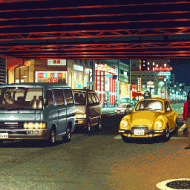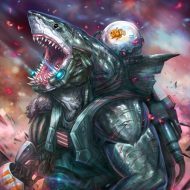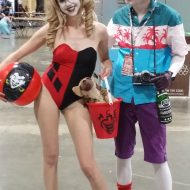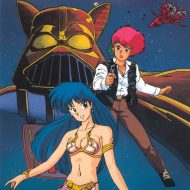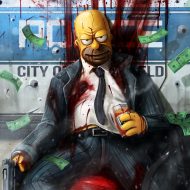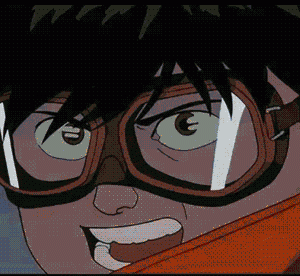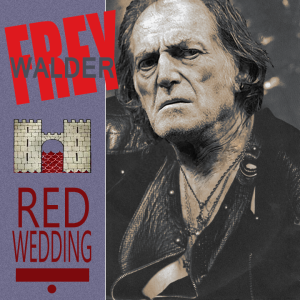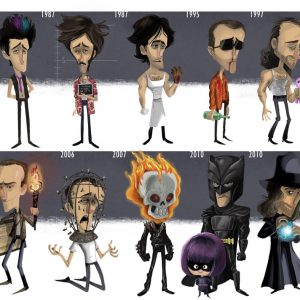10.21
Rowsdowr
Cult Film, TV, Geek Art
Alex Mitchell (genesischant) has taken the 1990s X-Men animated series line-up and reimagined them as Japanese samurai period drama characters.
Marvel’s X-Men are much more down-to-Earth characters compared to many superheroes. Contrasting with the larger-than-life figures of the Sengoku era, this time around I chose the relatively stable Edo Period in Japanese history, arguably the cultural high point in feudal Japan. Despite the lack of large-scale wars that marked the preceding years, social unrest was brewing that would eventually lead to the revolutionary changes of the Meiji era. Class stratification and government control was very strict, and those outside the bounds of society suffered prejudice and persecution. Against this political backdrop I set my X-men, outcasts from the mainstream, with powers and backstories that combine fanciful folklore, historical figures, and other culturally relevant stuff.
My Beast is Komainu. The character needed to be blue and monstrous, and I first thought to use some sort of oni or youkai, but I decided that it would be too far removed from reality (I needed to save the wild stuff for characters that really needed it). I was inspired by real-life Sengoku samurai Yoshitsugu Otani whose leprosy and loyalty are legendary. The mask fit the appearance I wanted, and the disease explained the desperate search for a “cure” that Beast is known for. The ‘komainu’ is a heavenly guardian dog (or lion) statue brought over from China with the spread of Buddhism.
Gambit was reinterpreted as Chouhan. I knew I wanted to use the ‘bakuto’ yakuza gambler archetype– famous blind swordsman “Zatoichi” is one of my favorite characters ever. The popular dice game ‘Chou-han’ was a good substitute for cards, and small bombs explain his ‘power’. The ‘kitsune’ (fox) lineage is a rumor common to some great men and women of unusual ability or attraction (kitsune made a habit of transforming and seducing humans). I thought ‘Dorobou’ (thief) was a fun match for ‘LeBeau’, and a good reference to the comics’ ‘Thieves Guild’.
Rogue is Onryou. I needed a character with vampiric powers, a white streak in her hair, and a no-touching complex. An ‘onryou’, or vengeful ghost seemed to be the answer. The reversed kimono, white head kerchief, lack of feet, and ‘hitodama’ ghost flames are all classic ghost traits. I meant for the character to be an escaped ‘oiran’ (high class courtesan) from Edo’s famous red-light district.
Storm becomes Kaminchu. I’ve always liked Storm’s early life as a goddess, so I decided to actually make her one. She hails from the (certainly at the time) exotic Ryukyu islands that stretch southwest from Kyushu. The language, religion, and culture differ from the mainland, with considerable difference island to island. ‘Kaminchu’ means ‘god person’, and is a general term for a variety of priestess/shaman/medium roles. I gave her an obi made from a ‘shimenawa’ (sacred rope) that marks out a holy site in Shinto.
‘Professor X’ is translated into ‘Master Zenji’. When I began this project, the question of what the X-men group was going to actually *be* loomed large. I decided that a sword school was the best option. It was the right size, the right level of independence, the right potential for secret motives. So Professor X would need to be an old swordmaster- one who had retired to teach his art. The manipulation of ‘ki’ (life force) is a high-level technique in many martial arts, and seemed a good fit for Xavier’s powers. (Oh, and check out that sword-cane!)
My ‘Jean Grey’ is reimagined as ‘Miko’. I’ve reinterpreted Jean Grey before (in occult Edwardian style), and I made her a spirit medium. This time, she is a ‘miko’, a Shinto shrine maiden. She works at the ‘Hououza’ (legendary bird, phoenix) Shrine, where they have enshrined the guardian animal of the southern sky, a vermillion bird. Jean has no real consistent costume details, save for her (very non-Japanese) red hair. I decided to trust in the concept– and apart from the X-‘mon’ on her top, the decorative patterning, and the bird motif she is dressed in classic miko attire.
‘Cyclops’ transforms into Dokugan. ‘Dokugan’ means ‘one-eyed’. I drew from the story of Date Masamune, who famously plucked out his own smallpox blinded eye. Where Masasmune was successful, my Dokugan would be forced out of the leadership of his clan. His power is based on the ‘tatarime’ or ‘jyashi’, the Japanese variant of the culturally universal ‘evil eye’.
My version of Wolverine is called Mujina. ‘Mujina’ is an old word for badger, but it can refer to a whole range of similar creatures and has a supernatural connotation. The cursed swords replace the trademark claws, and draw their inspiration from swordsmith Muramasa’s infamous blades. Mujina himself is based on the wandering ronin archetype, with Miyamoto Musashi (2-blade style) as a major source. The ‘manji’ (spiral swastika-like symbol) patterning is a reference to my Weapon X team, the ‘Manji-kai’.
Finally, Jubilee is transmogrified into Hanabi. Jubilee’s power is often compared to fireworks, so made her the heir to a fireworks guild. The two most famous fireworks guilds in real-life Edo-era were the Tamaya and Kagiya. They had a fierce rivalry, and they used to stage big fireworks battles, with supporters yelling “Tamaya!” or “Kagiya!”. Today, people still yell ‘Tamaya’ and ‘Kagiya’ while watching fireworks. I was very happy with how right-on her costume was. The yellow trenchcoat becomes a festival ‘happi’ jacket common for workers, likely her grandfather’s.
